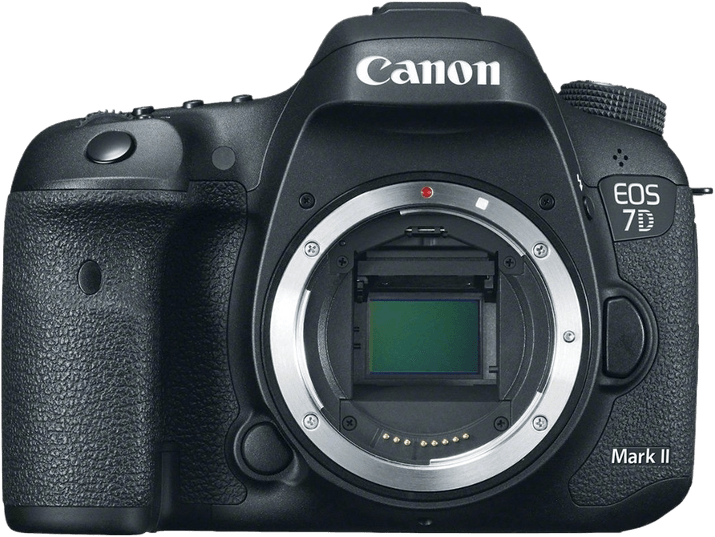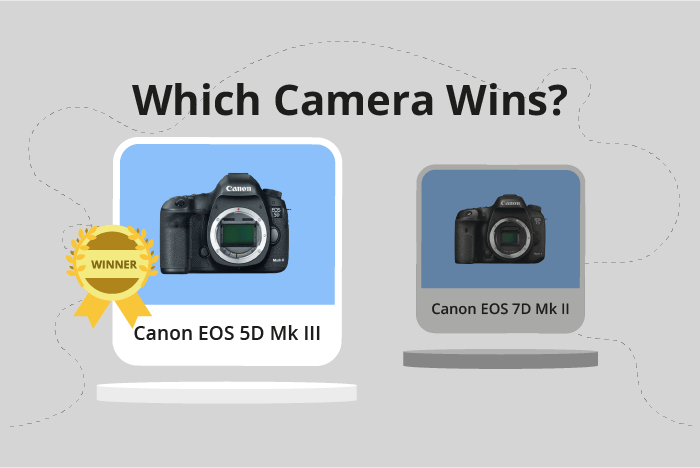Canon EOS 5D Mark III vs EOS 7D Mark II Comparison
Canon EOS 5D Mark III

Canon EOS 7D Mark II

The Canon EOS 5D Mark III outperforms the Canon EOS 7D Mark II, scoring 65/100 compared to the latter’s 60/100. Both cameras are DSLRs, released in 2012 and 2014 respectively. They share similar dimensions, with the 5D Mark III measuring 152 x 116 x 76mm and weighing 950g, while the 7D Mark II measures 149 x 112 x 78mm and weighs 910g.
The 5D Mark III’s higher score reflects its superior performance, despite its higher launch price of $3499 compared to the 7D Mark II’s $1800. However, the 7D Mark II still offers good value for its price and slightly lighter weight. Each camera has its own strengths, but the Canon EOS 5D Mark III ultimately stands out as the better choice.
Canon EOS 5D Mark III vs EOS 7D Mark II Overview and Optics
The Canon EOS 5D Mark III outperforms the Canon EOS 7D Mark II in optics, scoring 67/100 compared to the latter’s 61/100. Both cameras share some specifications, including a CMOS sensor, no image stabilization, and compatibility with Canon lenses. However, the 5D Mark III has certain advantages over the 7D Mark II, while the latter also has its own strengths.
One commonality between the two cameras is their lens mount: the 5D Mark III has a Canon EF mount, while the 7D Mark II has a Canon EF-S mount. This means both cameras can use Canon lenses, providing flexibility and compatibility within the Canon ecosystem.
The Canon EOS 5D Mark III surpasses the 7D Mark II in multiple aspects. With a full-frame sensor size, it captures more light and produces better image quality than the 7D Mark II’s APS-C sensor. Additionally, the 5D Mark III has a higher DXOMARK score for the sensor (81 compared to the 7D Mark II’s 70), which leads to improved image quality. The 5D Mark III also boasts a slightly higher megapixel count at 22.3, compared to the 7D Mark II’s 20.2, allowing for larger and more detailed images.
On the other hand, the Canon EOS 7D Mark II excels in shooting speed, offering 10 frames per second (fps) compared to the 5D Mark III’s 6 fps. This makes the 7D Mark II a more suitable choice for capturing fast-moving subjects or action shots.
In comparing the optics of these two cameras, the Canon EOS 5D Mark III stands out as the better choice for those prioritizing image quality and sensor size. However, the Canon EOS 7D Mark II may be more appealing to those who value faster shooting speeds for action photography.
Canon EOS 5D Mark III vs EOS 7D Mark II Video Performance
The Canon EOS 5D Mark III and the Canon EOS 7D Mark II have the same video score of 56/100. Both cameras share common video specifications, such as Full HD resolution, 1920 x 1080 video dimensions, and a maximum video frame rate of 60fps. Neither camera has built-in time-lapse functionality.
Despite having the same video score, the Canon EOS 5D Mark III has certain advantages over the 7D Mark II. The 5D Mark III features a full-frame sensor, which allows for better low-light performance and shallower depth of field. This results in more cinematic and professional-looking footage. Additionally, the 5D Mark III is compatible with a wider range of lenses, providing users with more creative options for their videography.
On the other hand, the Canon EOS 7D Mark II has a faster autofocus system, which is beneficial when recording fast-moving subjects or when using the camera for sports and wildlife videography. The 7D Mark II also has a smaller and lighter body, making it easier to carry around and use for extended periods.
Taking all factors into consideration, the Canon EOS 5D Mark III is better suited for those looking to create professional and cinematic videos, thanks to its full-frame sensor and wider lens compatibility. The Canon EOS 7D Mark II, with its faster autofocus system and lighter body, is more suitable for capturing fast-paced action and for situations where portability is a priority. Although both cameras share the same video score, the choice between the two ultimately depends on the user’s specific video requirements and preferences.
Canon EOS 5D Mark III vs EOS 7D Mark II Features and Benefits
The Canon EOS 5D Mark III outperforms the Canon EOS 7D Mark II in features with a score of 59/100, while the latter scores 57/100. Both cameras share some specifications, including a screen resolution of 1,040,000 dots, lack of a touchscreen, and absence of a flip screen and Bluetooth.
The 5D Mark III has a larger screen size of 3.2 inches compared to the 7D Mark II’s 3-inch screen. This advantage provides a better and more comfortable viewing experience for photographers. However, the 5D Mark III does not offer GPS or Wi-Fi capabilities, which are present in the 7D Mark II.
In contrast, the 7D Mark II boasts GPS and Wi-Fi features, enhancing its connectivity and location-tracking capabilities. These features are particularly useful for photographers who require geotagging or remote control of their camera. Despite these advantages, the 7D Mark II falls short in screen size compared to the 5D Mark III.
In comparing the Canon EOS 5D Mark III and the Canon EOS 7D Mark II, it is evident that the 5D Mark III offers a superior viewing experience with its larger screen size. On the other hand, the 7D Mark II excels in connectivity with its GPS and Wi-Fi capabilities. Ultimately, the choice between these two cameras depends on the photographer’s priorities and preferences.
Canon EOS 5D Mark III vs EOS 7D Mark II Storage and Battery
The Canon EOS 5D Mark III wins in the storage and battery category with a score of 76/100, while the Canon EOS 7D Mark II scores 65/100. Both cameras have two memory card slots and accept SD/SDHC/SDXC and Compact Flash cards. Neither camera offers USB charging.
The 5D Mark III has a superior battery life, providing 950 shots per charge compared to the 7D Mark II’s 670 shots. This longer battery life makes the 5D Mark III more suitable for extended photography sessions.
Although the 7D Mark II has a shorter battery life, it uses the LP-E6N battery type, which is an updated version of the 5D Mark III’s LP-E6 battery. This may offer some advantages in terms of battery performance.
In terms of storage and battery, the Canon EOS 5D Mark III is the better choice due to its longer battery life. The 7D Mark II, however, may have a slight edge in battery performance with the upgraded LP-E6N battery type.
Canon EOS 5D Mark III vs EOS 7D Mark II – Our Verdict
Are you still undecided about which camera is right for you? Have a look at these popular comparisons that feature the Canon EOS 5D Mark III or the Canon EOS 7D Mark II:

